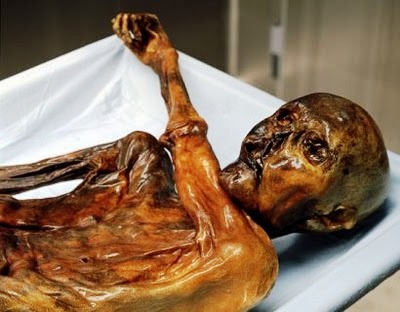
Otzi the Mummy and Acupuncture New
Revelations about Otzi's Tattoos Using optical microscopy and various powerful electron
microscopy techniques, Pabst, a professor in the Institute of Cell Biology at the Medical University of Graz, and
her colleagues analyzed several of Otzi’s tattoos. It is beleived that these crystals probably fell off stones in
the fireplace and mixed into the soot, rather than being purposely used to add sparkle to the tattoo. Obviously,
this is debatable. Supporting evidence that the tattoos were not just for aesthetic function include the fact that
the cross-shaped tattoo on his knee, and another one on his left ankle, lay over Chinese acupuncture trigger
points. It was believed that the earliest acupuncture took place in China around 3,000 years ago. Since the 5,300 year old iceman is much older, the researcher and her colleagues now think this technique may have been independently discovered by many different prehistoric European and Asian cultures. It’s also still possible that tattooing and acupuncture originated in East Asia, with the knowledge of this practice spreading to the Alps region well before the iceman’s lifetime. Frank Bahr, president of the German Academy of Acupuncture, first made the tattoo-acupuncture connection on the iceman after studying a drawing of the tattoos and their placement on Ötzi’s body. Bahr told Discovery News, “The most interesting thing about
the whole iceman story is that even today I would treat a patient with about 90 percent of the same points as the
tattoos on the iceman, if this patient were to have the same diseases.” The post makes an interesting point about the Tarim Basin in
China (based on DNA evidence) may have been a cultural crossroads in ancient times where ideas and technologies
could have been exchanged.
|


 Delicious
Delicious Digg
Digg Facebook
Facebook Google Bookmarks
Google Bookmarks Newsvine
Newsvine Stumbleupon
Stumbleupon Yahoo My Web
Yahoo My Web